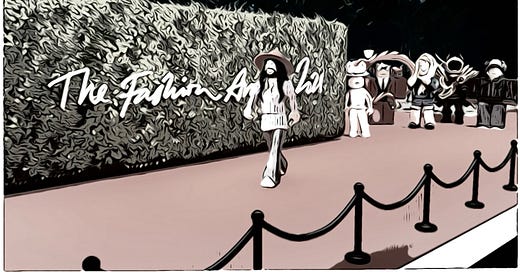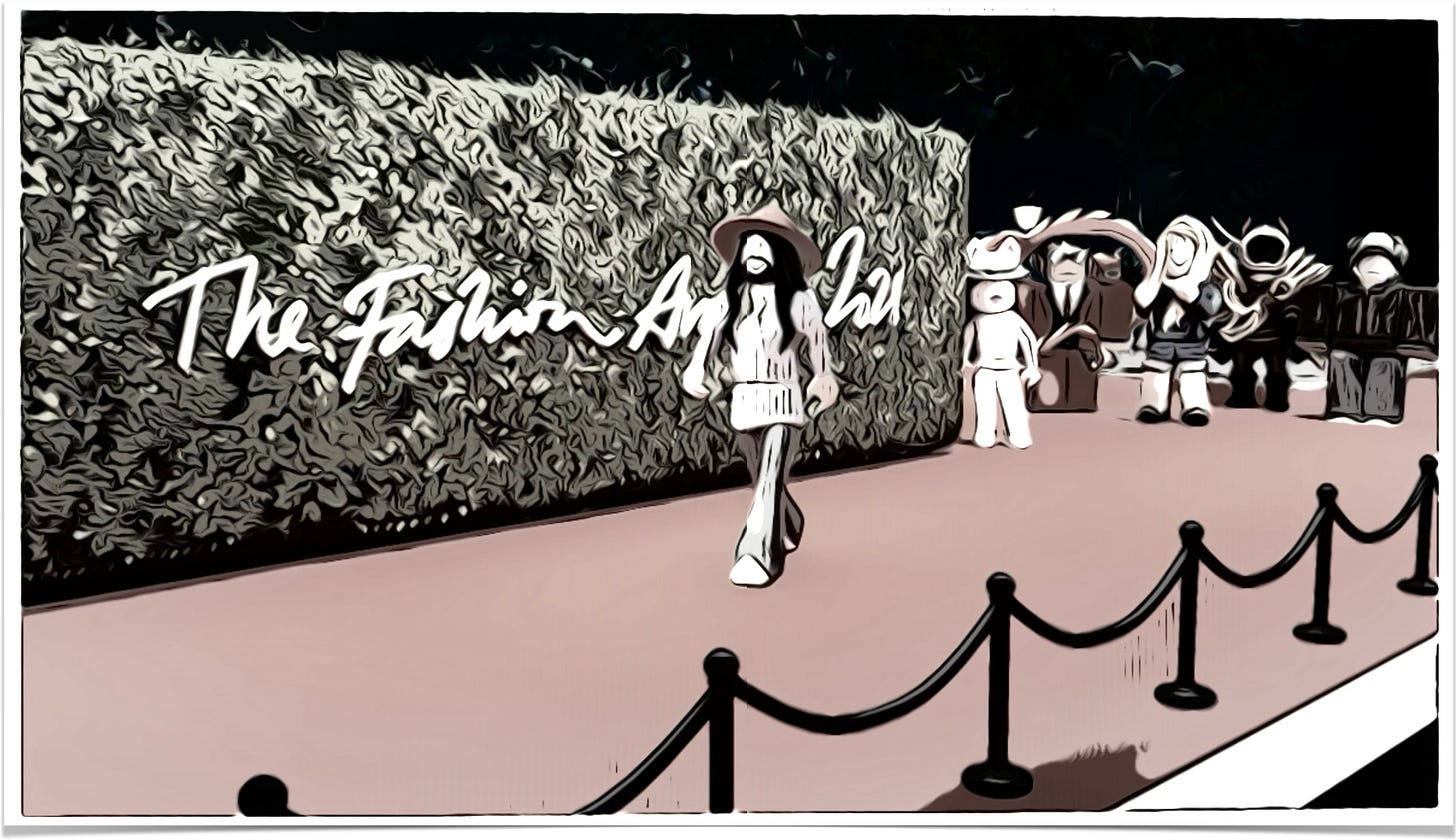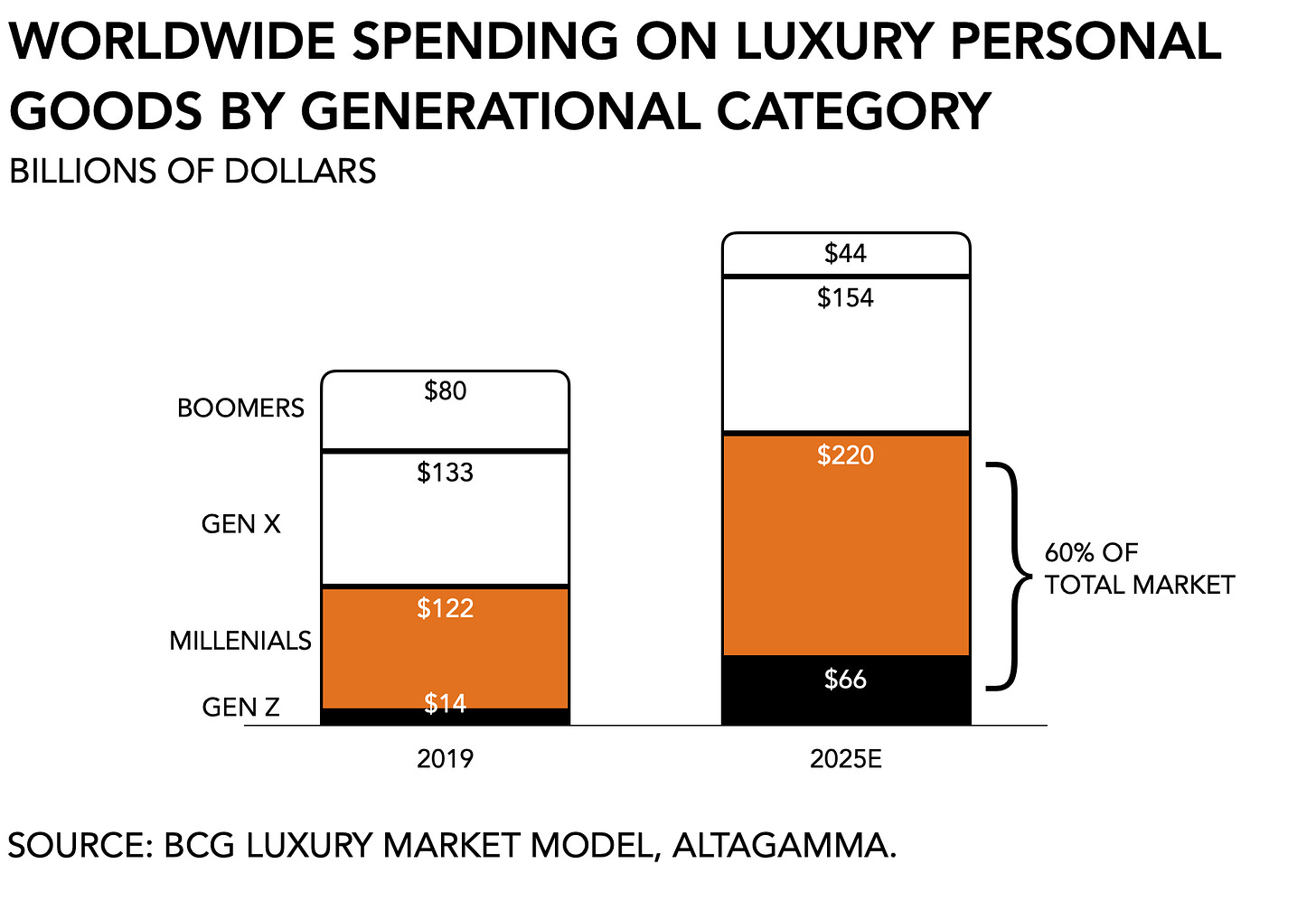This week I decided to explore digital fashion a bit further.
That’s because of two distinct reasons. First, dealing with the growing stack of dirty diapers from our newborn is a uniquely humbling experience. Just. So. Much. Poo. It is clear this week that she’s starting to get curious about solid foods and god help us when that starts. To offset some of this terrestrial bliss, my mind naturally wanders into the more esoteric realm to explore form, composition, and meaning. You know, fashion.
Second, the early death of rising LVMH designer, Virgil Abloh, is evidently leaving a hole not just in the apparel business, but also in music, luggage, furniture, and other creative categories. What stood out for me in the myriad of obituaries was Abloh’s ambition:
“I’m trying to create a luxury version, a designer version, of what I see in the street.”
His creative vision borrowed, mixed, and re-combined everyday objects with high-brow design while staying loyal to both. That oscillation between worlds made him the type of visionary to give shape within a historical moment when society wrestles with diversity and the digital.
It got me curious about the role of fashion at large as life increasingly takes place online and the metaverse starts to materialize.
On to this week’s update.
🎙 The next 100 million blockchain gamers
I recently joined a conversation with Antubel Moreda, creative director at The Pheonbix Lighthouse, and Sebastian Park, venture partner at BITKraft, which was hosted by Nico Vereecke (also BITKraft) on what’s next for blockchain gaming.
Many smart things were said. Check it out.
NEWS
Sony files patent application for an enormous handheld
Despite generally being considered technologically backward, Nintendo really did set the tone with the Switch by offering a handheld that offers a widescreen. Never-ending miniaturization means we can cram more content into smaller devices, and those devices take on multiple functions. Earlier this year the SteamBox made a splash (sometime in 2022), then Qualcomm hits us with whatever the hell this is, and now there’s Sony’s boomerang-sized thing. Considering the Japanese giant’s aggressive acquisition spree of media and entertainment IP in recent years, the proposed design falls in line with offering a hybrid device that facilitates both playing and viewing experiences. According to the patent, it’s as wide as Kenichiro Yoshida’s favorite pet can run in an hour, or one bloit.
Crypto-game regulations, cock-ups are here
A great week for the skeptics of blockchain gaming. First, fearing the potential of widespread gambling addiction, South Korean regulators have moved to ban NFT-based games. According to an official (who asked to remain anonymous btw) at the country’s Game Rating And Administration Committee:
“It’s not the blockchain technology that we are banning. […] What we are saying ‘no’ to is the application of NFT that can be connected to real assets.”
Effectively, the ban is among the first few anticipated regulatory changes as governments figure out their domestic stance on blockchain technology’s capabilities and formulate protective measures for consumers. Digital ownership and the attachment of real-world value to in-game assets is a contentious issue. Undoubtedly, many officials have a fresh memory of EA calling its overly aggressive loot box monetization tactics “surprise mechanics” during a parliamentary hearing in the UK.
Second, the makers of Wolf Game saw themselves forced to re-do their entire game after an exploit made it unplayable. The game revolves around wolf and sheep NFTs in a $WOOL-based matrix (go read it your own self). After identifying an exploit around unstaking its tokens that resembled a “reentrancy vulnerability” and bypassing a check to confirm transfers, the jig was up. Aaaanyway, it allows generating infinite amounts of its currency and consequently. Because the Ethereum blockchain is programmable and immutable, there’s no such thing as sending out a patch and the developer had to ask players to migrate to a second version. Up to that point, the game had been remarkably successful, generating $52 million within five days earlier this month.
One way to look at it is that it was an honest mistake and the hallmark of a game application on novel technology. Another is that this, for now, is as good as it’s going to get.
100 Thieves raises $60 million at $460 million valuation
As expected, esports is coming out of the pandemic stronger than it went in and has entered a new era. For one, it is getting capitalized faster than you can type. After FaZe’s billion-dollar moment a few weeks ago, now it’s 100 Thieves’ turn. Founded by former Call of Duty champion Matthew “Nadeshot” Haag, the gaming and lifestyle firm makes most of its money from merchandise sales and live-streaming. No surprised here. In 2020 it was on track to make $16 million in annual revenues.
BIG READ: Fashion’s metaverse moment
This week we saw the introduction of a new category for “metaverse design” by the British Fashion Council. In collaboration with Roblox, the organization nominated five in-game creators. The winner, cSapphire, runs a clothing boutique in Roblox.
To equate Roblox with the metaverse is a stretch, of course. But the symbolism of the new award category should not be too easily dismissed. As, especially, younger audiences spend a growing portion of their social life in shared digital settings, how they express themselves is going to be increasingly important. Just this week Softbank invested $150 million in South Korean firm Zepeto, a “fashion metaverse ecosystem” owned by Naver, which caters mostly to young women. Zepeto’s two million daily active users create and customize their avatars used to interact in its digital environment. Digital fashion plays a critical role in the presentation of self in an online setting.
In a sense, fashion companies waking up to the metaverse is a lot like banks getting serious about digital currencies. Where previously financial institutions would purposely look to box out tech entrepreneurs with their funny money, they have started to relent on their initial skepticism and, largely due to growing demand among retail investment clients, begun developing financial products around crypto-currencies.
The fashion industry has similarly started to beef up its digital presence. It needs little explanation that in particular, tech-savvy younger audiences have moved online and away from conventional marketing channels. To reach this ravenous consumer base, makers of apparel must necessarily follow. Coco Chanel’s observation that “every day is a fashion show and the world is your runway,” applies in equal measure to our physical and digital lives.
For all their high-brow artistry, fashion brands have been struggling like the rest of them. Gucci has been suffering an ongoing decline in North America, seeing both its sales and social media clout evaporating. That is fatal for industries that rely largely on effective marketing, especially if popular sentiment turns against them. And that it has. Its tone-deaf design of a “black-face sweater” forced Gucci to issue a mea culpa and remove it from online and offline stores.
Better to break new ground and incorporate gaming into a brand’s communication toolkit. Over the past few years, we’ve seen several foreshadowing initiatives. Prada collaborated with Square Enix for a fashion shoot to celebrate Final Fantasy’s 25th anniversary. In 2019, Burberry launched an online game called B Bounce on its main website, and more recently announced its partnership with Mythical Games. Gucci released a smartphone app that featured arcade games to take players on a journey of the fashion label’s history. And long before we had Arcane on Netflix, Louis Vuitton dressed up marque characters from League of Legends. A study in April this year on contemporary spending habits among consumers across 12 markets found that a whopping 86 percent of people that had purchased the digital version of an in-game luxury item also bought the corresponding physical version.
Now, two simultaneously occurring developments are positioning the intersection between fashion and gaming as a cornerstone experience of the early metaverse.
The first is based on the observation that population size serves as a proxy and catalyst for cultural complexity. Gaming had already crossed the 3 billion people threshold. The pandemic, and now a supply chain shortage, has pushed greater numbers higher still. As we find ourselves surrounded by more and more people, the need for expression and a distinct manifestation of our individuality increases.
This is the first application. Fashion, generally found under the moniker ‘vanity items’, plays an integral role in distinguishing ourselves and others. The early success of Tencent was the sale of novelty user IDs for its QQ chat service. Not names. Numbers. As a combination of superstitious good fortune and social competition, Chinese consumers proved more than willing to spend.
How we are perceived in a digital environment is, in effect, a form of utility, which is so often considered a central tenet to game design and runs far deeper than buffing a character’s stats. In online worlds, social capital and the means to influence it are equally important.
That’s not a new phenomenon. The popularity of Pokémon can be traced back to the early day taglines from its cartoons. A generation of 13-year olds gave meaning to the phrase: “I choose you, Pikachu” by making editorial decisions on what deck to build, their preferred creatures, and playstyle. Both the GameBoy versions of the game and the collectible card games were easy to put into a backpack and carry to school. Too young to be considered adults and too old to be patronized completely, that awkward age group thirsts for independence and an expression of individuality, and Pokémon gives it to them.
In the digital cacophony to come, agency facilitated by decision-making, the eternal ergodic nature of play, is only going to become more important in the metaverse. From this perspective, user-generated content today is only just an early manifestation of one’s genuine commitment to life online. A tagline among early hobbyist game makers, or modders, was “He who loves the game, mods the game. He who mods the game, lives the game.” As online audiences grow and different realms and applications connect to each other, it will require more complex ways to communicate with and identify each other.
Hardest button to button
Secondly, technology is starting to catch up to social behavior. The early iterations of technology and their underlying business models that connect the dots have started to manifest.
One obvious example is the digital verification of authenticity. Walmart and other giant retailers, for instance, have started relying on blockchain to facilitate ‘track and trace’ systems for its produce. Despite its current shortcomings, there are ample applications that combine such real-world exchanges with digital authentication. Similarly, a ‘Proof of Attendance Protocol’, or PoAP, presents a digital badge that validates someone’s attendance at a specific real-life event. Even the most ardent skeptics in the games industry are likely to have a drawer somewhere filled with conference badges that show how many years back they first went to E3.
Next, if you understand the emphasis on great storytelling, professional voice acting, and epic musical composition as essential components to contemporary blockbusters games, it becomes easier to see why textures and palettes may soon play an equally important role.
An increase in computing power and the broadening in the range of available digital materials means people regain expressive agency. Industrialization eradicated personalization when it pushed penmanship and handwriting out in favor of the more consistent and uniform typesetting of mechanical writing.
“In der Machinenschrift sehen alle Menschen gleich aus.”
We are at the cusp of a surge in new technologies that are more accessible, and more powerful in terms of creative expression than previous generations. Already did we see the vast improvements in Unreal Engine 5. But there’s also an array of startups that seek to build ever-more detailed online environments. One example is Atomontage which offers highly detailed cloud-based volumetric worlds where people can impact objects and the environment. Another, RTFKT, creates digital sneaker designs and combines it with physical redemptions that allow NFT holders to receive real-world sneakers. And Genvid focuses on enabling what it calls ‘massive interactive live events’, or MILEs, in which millions of simultaneous viewers impact what happens in its zombie survival game Project Raven.
Fashion occupies the space between the real and the digital world. Cool outfits from fantasy games have appeared on the runway and fashion designers have drawn up new ways to dress in-game characters. What things look like and how people express themselves is what gives life to these digital worlds.
An early example of how games and fashion can successfully interact was Kim Kardashian: Hollywood, a mobile game developed by Glu Mobile (now part of EA) where players scurry from red carpet events to photoshoots, all the while egged on by Ms. Kardashian. As mobile games started to penetrate mainstream audiences, leveraging celebrities proved highly effective in attracting players who were all too eager to spend.
“The whole idea was to make it feel as live-time as possible. I would give [Glu] bikinis and be like, ‘Hurry up and mock up this bikini, because I’m going to wear it, and then you can have it live in the game!”
Call it vapid and faux fashion all you want, but for millions of people, it was meaningful.
Beyond these rudimentary crossover initiatives, there is now also a growing push into digital-only fashion. Firms like Fabricant pride themselves on being ‘always digital, never physical’ and position themselves as digital fashion houses that make clothing to “be used and traded in virtual realities.”
Against this background, even something as seemingly trite as a digital runway show hosted in Roblox and judged by model Karlie Kloss starts to make more sense. Much of it still resembles mere digital incarnations of real-world experiences. But all of it lends itself to facilitating unique and meaningful digital experiences in a synthetic world with fashion, as ever, leading the way.
PLAY/PASS
Play. Garry Gasparov got himself roped into playing competitive Hearthstone. Not sure if a master chess player’s affinity for another game elevates it to a higher level per sé, but the man’s grace, in the end, makes it worth watching.
Pass. Activision Blizzard is facing some real pressure now that treasurers from six states (California, Massachusetts, Illinois, Oregon, Delaware, and Nevada) have called it to the mat by December 20 to address unequal pay and other issues.








